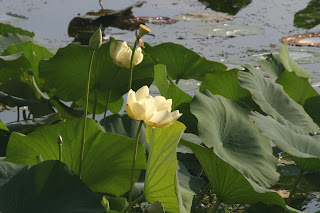This summer was
particularly wet. There was plenty of rain, thunder, and lightning, and while
we were likely holed up in our houses, warm, safe, and dry, our wild feathered friends were outside. Although they might
not have the luxury of a roof and four walls, birds have their own methods of
surviving inclement weather.
First and foremost, birds
take shelter during a storm. Fortunately most of our backyard birds are small
in size, allowing them to take advantage of microhabitats. Hiding in the small
spaces inside a hedge or on the lee side of a tree can make all the difference
during high winds. Instead of being buffeted by driving wind and rain, a little
bird will stay relatively warm and dry.
Preparation for storms is
crucial, because birds will not be foraging for food during inclement weather;
instead, they will devote their energy to staying safe and warm. Birds may be
able to detect changes in barometric pressure, which would explain how they
know to increase foraging activity before a storm hits. The extra fats and
other nutrients that a bird acquires during this foraging give the bird a
better chance of survival.
Of course, some storms are
too severe for birds to safely weather. Tornadoes, for example, are so
destructive that even taking shelter in microhabitats is not likely to protect
a bird. The only sure way to survive a tornado is to avoid one – which is
exactly what some birds do. A recent study on migration accidentally discovered
that birds that had already returned from migration went out of their way to
avoid a storm system that was producing tornadoes.
Warblers (a group of birds
within the songbird order called Passeriformes) that
had been outfitted with trackers showed something odd: the birds suddenly
traveled 400 miles south of their breeding grounds. A day later, scientists
noted a massive storm system moving towards the area the warblers vacated.
Because the weather conditions were still normal as far as the researchers
could tell, they are not entirely sure exactly how
the birds detected the storm.
They believe, though, the warblers may have been able to detect the
low-frequency sound that tornadoes produce. Such a deep sound, below the
hearing capacity of humans, can travel well ahead of the storm and warn any
animals that can hear it.
Mother nature can be
fickle, and birds must be resourceful to deal with the variety of conditions
that nature can throw at them. Especially in a changing climate, birds must be
able to adapt, and ultimately evolve, or else perish.
Submitted by JoHanna
Burton, World Bird Sanctuary Naturalist































